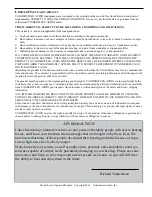
9 Model Seven Operation Manual
center of the speaker’s grille frame should be away from
the wall behind the speaker.
Now we can graph these odd dimension distances on a
drawing of the room. We only need to graph them for the
wall where we intend to place the speakers.
20
72 43 31 24
We use the same method to figure how far the top front
center of the speaker’s grille frame should be from the side
walls. We take the width of the room, (14 feet) convert it
from feet to inches, (14 x 12 = 168) and divide the result
by odd numbers.
168 divided by 3 is 56 (all to the nearest inch)
168 divided by 5 is 34
168 divided by 7 is 24
168 divided by 9 is 19
168 divided by 11 is 15
The results of these odd number divisions are the dis-
tances in inches that the top front center of each speaker’s
grille frame should be away from the side wall.
Now we can graph these odd dimensions distances on a
drawing of the room.
By overlaying the width and length graphs, we can see
the intersection points of the lines. These points represent
where the top front centers of the speakers’ grille frames
should be.
15
24
34
56
56
34
24
15
20
72 43 31 24
As you can see, we now have quite a few intersections
to choose from in our example room. In your room, some
of the intersections will be impossible to try or eliminated
due to domestic considerations.
As you try different placements for your speakers, al-
ways place both speakers on the same length line. For
example, both speakers would be placed on 43 inch line
or both speakers would be placed on the 24 inch line. The
speakers can be placed on different width lines, for exam-
ple one on the 34 inch line and the other on the 56 inch
line. Placing the speakers on different rather than match-
ing width lines will require that the listening position be
offset to center it between the speakers. Often the imaging
will be better with the speakers placed on matching width
lines.
After listening to the speakers centered on the charted
intersections, you should listen with the speakers a few
inches away from the intersection points in each direction.
In some cases, the speakers will sound better slightly off
the intersections due to the particular characteristics of
your room or a slight error in your original room measure-
ments. Both speakers should be moved the same amount
forward or backward to maintain a consistent listener to
speaker distance when fine-tuning placement.
Several factors influence how speakers interface with a
room other than the room’s basic dimensions so it is pos-
sible that none of the placement options on the wall you
initially place the speakers on will sound quite right. The
sound may be too forward or too withdrawn or the imag-
ing may not be to your liking. If you are unable to
achieve satisfactory sound with the speakers placed on
one wall, try placing the speakers on a different wall of
the room. Even in a rectangular room, the speakers will
interface differently with the room depending upon which
of the four walls they are placed. In some rooms the
speakers will sound best placed on a short wall, while in
other rooms the speakers will work better on a long wall.
15
24
34
56
56
34
24
15




















